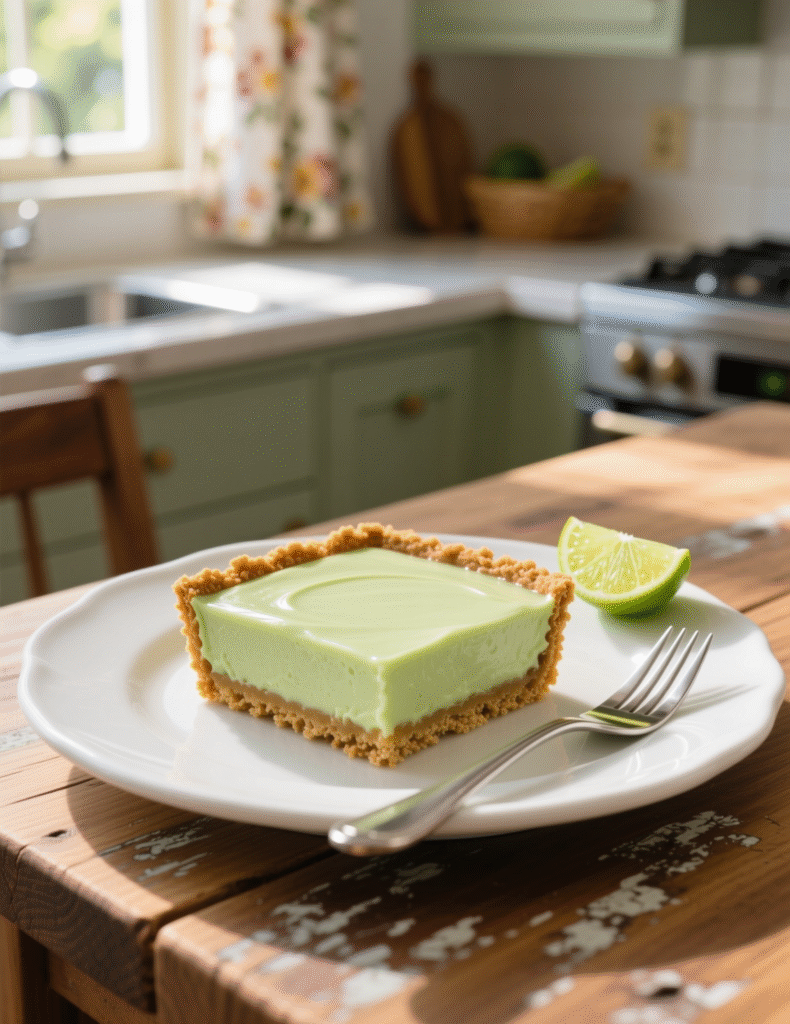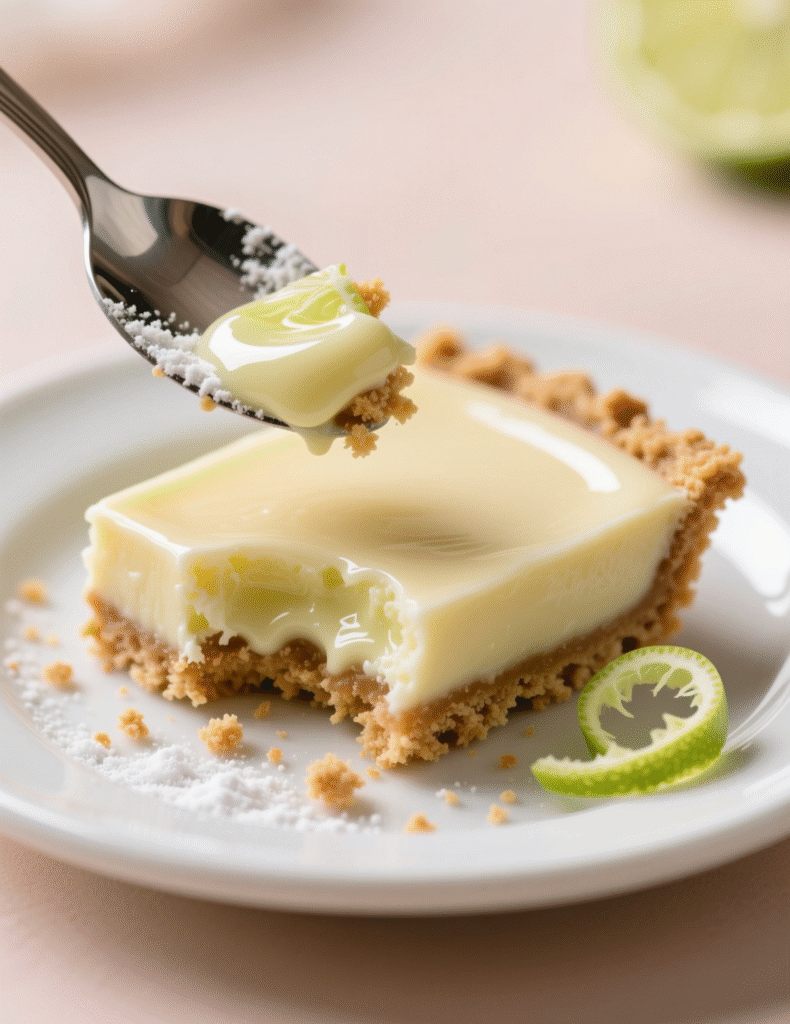Key lime pie is no stranger to dessert tables, but key lime pie bars are the form that slips into your life without making a scene. They’re sharp, creamy, and a touch indulgent, yet they stack neatly into squares like they’re trying to behave. These bars make sense when you’re feeding a crowd, but they also hold their ground as a professional-level dessert. In this guide, we’ll dive deep into the making of these bars—recipe, technique, history, and the little tricks that separate good from unforgettable.
Why Key Lime Pie Bars Work Better Than Pie
There’s an efficiency to bars. You cut once, serve twelve, and the slices are even. No sagging crust when you lift it out, no arguments about who got the larger wedge. Professionals know that desserts designed for consistent portioning make service smoother. Bars also cool and set faster than a full pie, thanks to the reduced surface area of each square.
And here’s the big one—transport. Key lime pie bars slide into trays and go anywhere, while a whole pie always feels like it’s waiting to collapse mid-journey.
Understanding the Flavor Profile
Key lime is not the same as regular lime. Key limes are smaller, seedier, and they throw a more complex tartness. The acidity sits high, almost floral, and it cuts right through the richness of sweetened condensed milk. Without this sharpness, the dessert can quickly tip into cloying.
If you can’t source key limes, Persian limes do the job, but the flavor softens. Some chefs mix the two—half key lime, half Persian—to stretch the juice without losing the perfume. A small study by the University of Florida in 2017 found that consumers rated desserts with key lime juice significantly more aromatic and “punchy” than those with Persian lime juice alone. That’s not just preference; that’s chemistry at work.
Ingredients at a Glance
For a standard 12-serving tray of key lime pie bars, here’s the blueprint:
- 1 ½ cups graham cracker crumbs (finely ground, not chunky)
- ½ cup unsalted butter, melted
- ⅓ cup granulated sugar
- 4 large egg yolks (room temperature)
- 1 can (14 oz) sweetened condensed milk
- ½ cup fresh key lime juice (about 20-25 key limes)
- 1 tablespoon zest from key limes
- Whipped cream, lightly sweetened, for garnish
Professionals adjust sugar levels depending on lime quality. Overripe limes may taste less acidic, requiring a pinch more juice or zest to balance.

The Science of the Crust
Graham cracker crust isn’t just a base. It’s texture management. The sugar caramelizes under heat, the butter binds, and the result is a crumb that holds form when cut but shatters gently under a fork.
Ratio is key. Too little butter and the crust crumbles. Too much butter and it turns greasy, sliding under the filling like wet sand. The sweet spot sits at around 8 tablespoons butter for every 1 ½ cups crumbs. This creates the right cohesion without soggy weight.
Pre-baking the crust at 350°F for 8–10 minutes is non-negotiable. It locks structure and prevents raw crumbles in the finished bar. Professionals sometimes go 2 minutes longer, just to coax a nutty depth from the graham.
Building the Filling
This filling is chemistry disguised as dessert. Egg yolks carry lecithin, an emulsifier, that binds fat from condensed milk with the acid of lime juice. Once whisked together, the mixture thickens almost instantly. You’ll notice it clings to the whisk in ribbons—that’s the acid reacting with proteins.
Sweetened condensed milk isn’t just a shortcut; it’s tradition. It was first used in Florida’s early key lime pies because refrigeration was rare in the 1930s. The milk’s density balances acidity while its sugars stabilize the custard during baking.
Bake the filling low, around 325°F, for 15–18 minutes. You want the center barely set, still a bit jiggly, because carry-over heat does the rest. Overbake, and the filling loses its silky texture, turning grainy.
Cooling and Cutting
Patience wins here. Chill the bars for at least 4 hours, preferably overnight. Cutting too early smears the filling, no matter how sharp the knife. Professionals use a hot knife dipped in warm water, wiped between each cut, for edges that stay clean.
Bars hold best at 2×2 inch squares. Anything larger becomes awkward to eat, especially at events. Twelve servings is ideal for a 9×13 inch pan, but you can stretch it to 16 if portion control matters more than indulgence.
Garnish and Presentation
Whipped cream is classic, but don’t pipe it hours ahead or you’ll watch it collapse into puddles. For service, stabilize whipped cream with a touch of gelatin or mascarpone. A sprinkle of zest signals freshness, but keep it light—too much zest can turn bitter.
Chefs in high-volume kitchens often serve bars with a thin slice of candied lime. It’s elegant and doubles as a textural surprise. Some even drizzle with white chocolate for contrast, though purists may grumble.
Professional Tips and Troubleshooting
- Bars cracked on top: Oven too hot or overbaked. Lower temp, pull earlier.
- Crust falls apart: Not enough butter or not pressed firmly. Use the bottom of a measuring cup to compress.
- Bars too sour: Limes overripe or juice quantity too heavy. Cut back by 1–2 tablespoons.
- Bars too sweet: Increase lime juice slightly, or add a touch more zest.
Professionals also consider storage. Bars refrigerate well for up to 4 days, and they freeze decently if wrapped tight. Thaw in the fridge overnight, not on the counter, to prevent weeping.
Nutritional Snapshot
Each serving (without garnish) delivers around:
- Calories: ~280
- Fat: 13g
- Carbs: 35g
- Protein: 5g
Key lime desserts aren’t diet food, but their portioned nature keeps indulgence reasonable. Interestingly, studies show that desserts with higher acidity are perceived as “lighter,” even if calorie counts remain the same. So diners often leave satisfied without overindulging.
Cultural Context
Florida’s Key West is the birthplace of this dessert, and authenticity still matters to many. The original pies used sponge crusts instead of graham crackers, and they were never topped with meringue. Meringue appeared later, more as a bakery flourish than a regional truth. Bars, however, are a modern adaptation, made popular in the late 20th century as home bakers sought easier serving options.
Even in fine dining settings today, bars show up as part of plated desserts, often paired with coconut sorbet or caramel tuile for contrast.

Common Misconceptions
Some believe bottled key lime juice works just as well as fresh. It doesn’t. Bottled versions often taste metallic or flat, and blind taste tests consistently prove fresh juice superior. A 2019 blind study at a Miami culinary school showed 87% of tasters preferred desserts made with fresh juice over bottled.
Another misconception—bars don’t need baking since lime juice “cooks” the eggs. This method is risky. Acid does thicken, yes, but it doesn’t eliminate pathogens. Professionals always bake custards to at least 160°F internal temperature.
Emerging Trends
Plant-based versions of these bars are growing. Chefs substitute coconut milk for condensed milk and agar or aquafaba for eggs. While they don’t mimic the exact richness, they create a dessert suitable for vegan or dairy-free diners. This trend reflects the broader shift toward inclusive menus, especially in catering.
Some experimental bakers also play with crusts—gingersnap, vanilla wafer, even pretzel for a salty edge. These variations expand flavor but must be balanced carefully so they don’t overpower the lime.
Conclusion
Easy key lime pie bars aren’t just a shortcut; they’re a modern evolution of a classic dessert. For professionals, they solve logistical problems of portioning, plating, and transport, while maintaining the iconic balance of tart and sweet. The key lies in respecting the chemistry—fresh juice, proper ratios, gentle baking, patient cooling.
For anyone cooking at scale, this recipe for 12 servings provides reliability without compromise. But within that structure, there’s room for play—different crusts, plating styles, garnishes. In the end, the lime leads the dance, and everything else follows its rhythm.
FAQs
Can I use bottled lime juice instead of fresh key lime juice?
Fresh juice is always better, bottled tends to taste flat or metallic.
How many key limes do I need for ½ cup of juice?
You’ll need about 20–25 small key limes to get enough juice.
Can I make key lime pie bars ahead of time?
Yes, they set best overnight in the fridge and taste even better the next day.
How long do key lime pie bars last in the fridge?
They keep well for up to 4 days when stored airtight.
Can I freeze key lime pie bars?
Yes, freeze tightly wrapped and thaw in the fridge overnight for best texture.
Why did my crust fall apart?
It likely had too little butter or wasn’t pressed firmly enough before baking.
Why are my bars cracking on top?
They were probably overbaked or baked at too high a temperature.
Can I make these bars without eggs?
Yes, use vegan substitutes like aquafaba or agar, though texture changes.
What size pan is best for 12 servings?
A standard 9×13 inch pan yields twelve neat squares.
What toppings work well besides whipped cream?
Candied lime slices, toasted coconut, or a drizzle of white chocolate all work nicely.

Marie Smith is a passionate recipe blogger, sharing easy, delicious, and creative culinary ideas that inspire home cooks to elevate everyday meals with flavor and simplicity.
